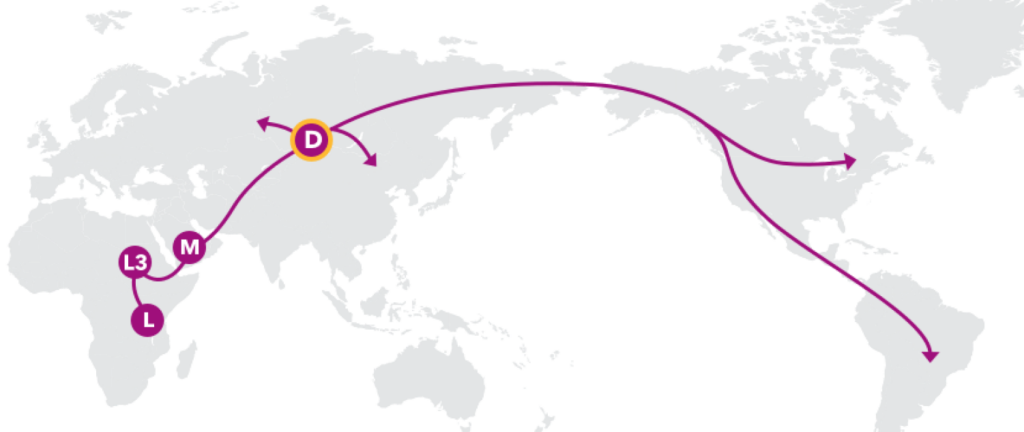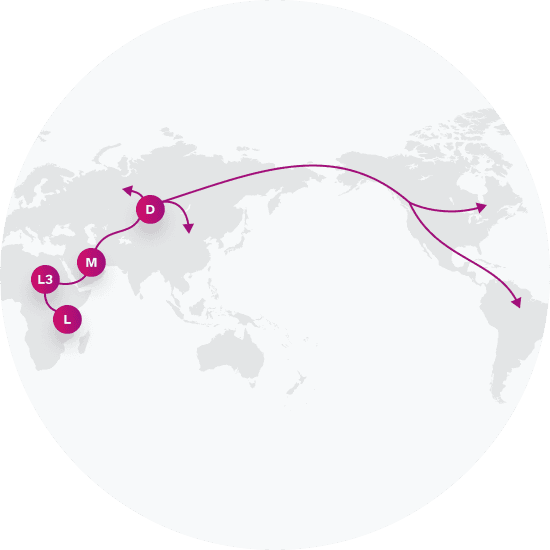What are haplogroups?
Haplogroups are genetic classifications or ancestral groupings within a population, typically defined by shared, inherited genetic markers or mutations. These markers are passed down from a common ancestor. They can be traced through the analysis of mitochondrial DNA (mtDNA) for maternal haplogroups and the Y chromosome for paternal haplogroups. Haplogroups provide insights into human populations’ historical migrations and evolutionary history, helping researchers and genealogists understand the genetic relationships and ancestral origins of individuals and groups.
Many 23andMe customers that contact Customer Care are confused by their haplogroup assignments and what they actually mean.

If you still aren’t sure what your haplogroup is, check out our DNA Ancestry Test as a first step. Knowing your haplogroup, and how you can use it, can give you much more clarity about your own ancestry. So in the interest of helping you out, we will walk through an example of a maternal and paternal haplogroup assignment, and explain how knowing your haplogroups can place you in the human family tree and connect you to your ancestry.
Haplogroup Assignment Example
In this case we’re using someone who is Asian, who has roots in Southeast Asia. But his maternal haplogroup – B4’5 and more specifically subgroup B5a1a – is most commonly found among Native Americans of the U.S. Southwest and northern Mexico.
Haplogroups Can Help Uncover the Migration of Your Ancestors
So why is that?
What connects him to Native Americans?
This is where understanding a little bit about haplogroups is helpful in placing you and your ancestry in the broader context of human history. Each haplogroup describes individual branches – or closely related groups of branches – on the genetic family tree of all humans. All members of a haplogroup trace their ancestry back to a single individual.
In this case, the individual shares his maternal haplogroup with many Native Americans because 12,000 years ago people migrated from Asia to Alaska, when sea levels were lower.
Or another way of looking at it is that descendants of his ancient maternal ancestor – a common ancestor he shares with many Native Americans – had crossed the Bering Land Bridge to populate the Americas.
Looking deeper into his results his maternal haplogroup is a subgroup of B4’5, specifically B5a1a. It has its own history where it broke off from B4’5 in Southeast Asia.
Recent migration patterns have altered the global distribution of this haplogroup, but that ancient history is written in his DNA and being able to read that and identify his maternal haplogroup connects him to that history.
The ability to trace back a person’s maternal haplogroup back so far – more than 50,000 years in the case of B4’5 – has to do with how it is passed down to each of us from our mother, and her mother, and her mother’s mother, and so on back in time.
The Difference Between Maternal and Paternal Haplogroups
Understanding the differences between a maternal and paternal haplogroup, goes can help you better use this information to better understand your ancestral origins.
Maternal Haplogroups
Maternal haplogroups are determined by defining variants in your mitochondrial DNA. Everyone inherits their mitochondria from their mothers. Unlike your other pieces of DNA, your mitochondrial DNA is the only type of DNA that is found outside of the nucleus. For this reason, your mitochondrial DNA does not recombine with other types of DNA. Because your mitochondria is inherited directly from you mother and undergoes very little recombination, you will share the same maternal haplogroup with any relative you share a direct maternal line with. For example, you, your mother, your brother, your sister, your maternal aunt, your maternal grandmother, etc. would all share the same maternal haplogroup as you. And that maternal haplogroup traces back through the generations to a single mutation at a specific place and time.
In the case we’re looking at, his maternal haplogroup is one that is shared by many people, not only of Han Chinese ancestry, but also with many Polynesians, Native Americans, and Southeast Asians.
Paternal Haplogroups
Now that we’ve looked at maternal haplogroups, we can turn our attention to paternal haplogroup assignments. In this case the person’s paternal haplogroup assignment is O3a3c1*.
It traces to East Asia and is also common among Han Chinese, Koreans, Filipinos and Malaysians. The paternal haplogroup assignment is determined by defining variants in your Y Chromosome. The Y chromosome is the sex-determining chromosome for males, which men inherit from their fathers. Therefore, unless you inherited a Y chromosome from your father, you will not have a paternal haplogroup assignment. (You can find out more about this here.) This is why women will see this page is unavailable to them within their 23andMe account, but in a moment we’ll explain how women can determine their paternal haplogroup.
First understanding a little bit more about the the Y chromosome is helpful. The Y chromosome does undergo recombination with the X chromosome, but only does so at the ends. So about 95 percent of the Y chromosome remains relatively intact across generations. For this reason, the Y chromosome is a reflection of your ancient paternal ancestry. You would therefore share a paternal haplogroup assignment with any male relative that you shared a direct paternal line with.
Paternal Haplogroups and Women
A woman can infer her paternal haplogroup if a male relative on her paternal line has been genotyped by 23andMe.
Because both the Y chromosome and mitochondrial DNA change so little over generations, they are very informative about your ancient ancestry. But that is not to say that they do not change at all. In fact, each letter and number that you see within your haplogroup corresponds to a set of defining mutations in your mitochondrial DNA or your Y chromosome. This marks a period in time when your haplogroup branched off into a distinct line. So, for example, it may mark when a population first migrated out of Africa, or when another group became geographically isolated.
Assigning Haplogroups
23andMe is able to trace your ancestry based on these mutations. That is because they occurred in distinct geographical locations during specific periods of time. Haplogroup assignments can even be traced back to specific languages.
That DNA evidence is often corroborated by the fossil record. Our oldest fossils date back 200,000 years. They were found in Omo Kibish in Ethiopia. According to genetic and paleontological records, Homo sapiens only began migrating out of Africa 60,000-70,000 years ago. They moved from Africa into the Eurasian continent.
Some of these migrants moved along the Indian coast reaching first Southeast Asia. They then migrated to Australia around 50,000 years ago. Since then, different migratory events have spread our species across the continents along different routes and paths.
We are able to trace migratory patterns based on defining mutations in mitochondrial DNA and Y chromosome DNA.
In the case in this post, ancient ancestors who were part of his maternal haplogroup were among a group of individuals who were in Southeast Asia. Some of those individuals eventually migrated across the Bering land bridge to populate the Americas. Some stayed around East Asia and developed some new defining mutations in their mitochondrial DNA making them B5a1a.
It is important to keep in mind that your mitochondrial DNA and Y chromosome account for very small portion of your DNA. It is also a small portion of your overall ancestry.
Autosomal DNA
As most haplogroups arose over tens of thousands of years ago, these pieces of DNA generally reflect your very ancient ancestry. It’s possible for two people to share the same haplogroup assignment but no recent ancestry. So for example, while you may share a paternal haplogroup with Stephen Colbert, you probably don’t share any recent common ancestors.
A large portion of our DNA is found within your autosomal DNA. This DNA undergoes recombination with each successive generation. Your results analyzing your autosomal DNA therefore generally reflect your ancestry from within the past five to ten generations. Therefore, it is not uncommon for the ancestry found within your haplogroup or your Ancestry Composition to differ from your own. This does not mean that any of these pieces are incorrect. They are each simply describing a different part of your rich and unique ancestry.
Learn More
You can find out if your genetics might Increase your risk for any health conditions with 23andMe. You can see a more recent blog post about haplogroups here.




